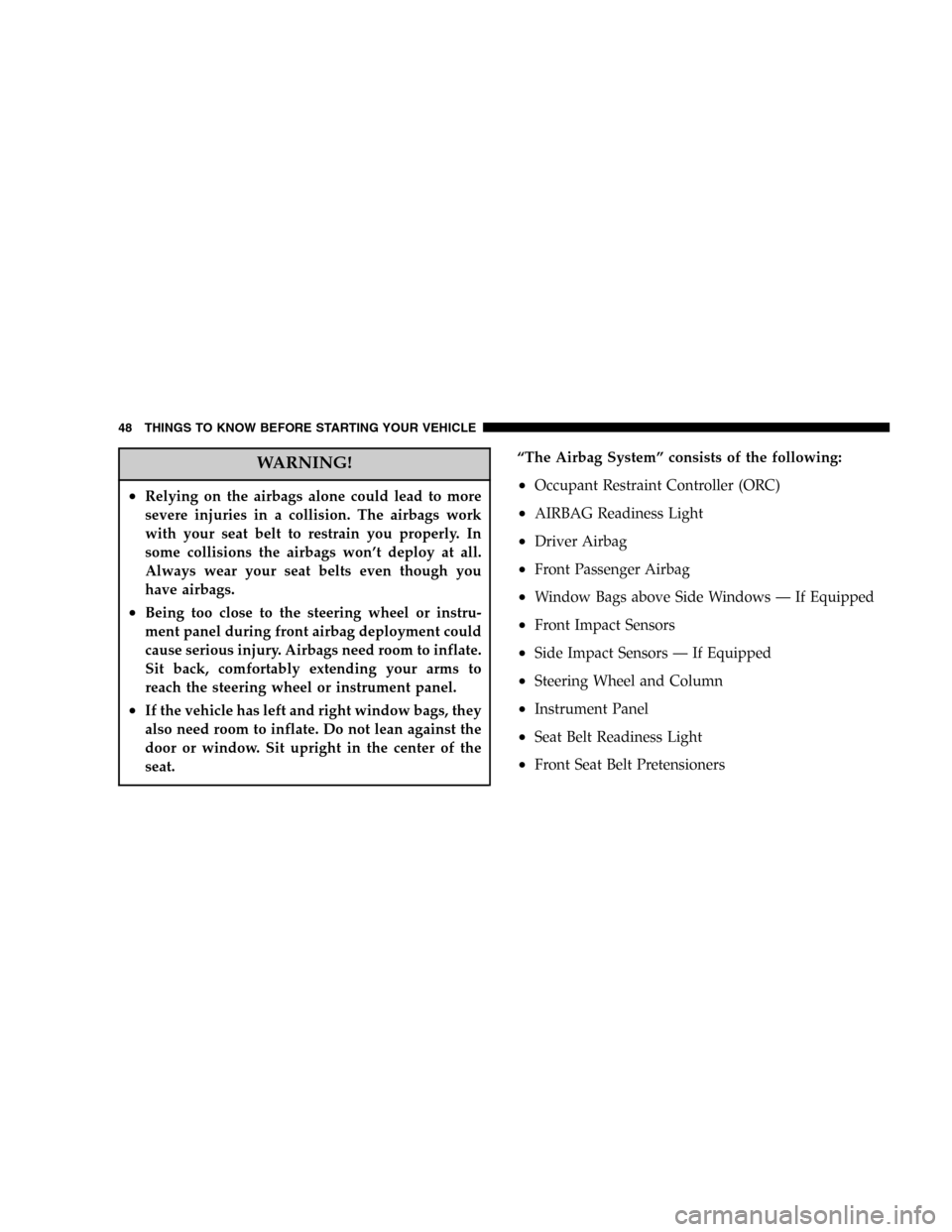Page 35 of 420
Lap/Shoulder Belt Operating Instructions
1. Enter the vehicle and close the door. Sit back and
adjust the seat.
2. The seat belt latch plate is near the seatback of the
front seats and next to your arm in the rear seats. Grasp
the latch plate and pull out the belt. Slide the latch plate
up the webbing as far as necessary to allow the belt to go
around your lap.
Latch Plate
THINGS TO KNOW BEFORE STARTING YOUR VEHICLE 35
2
Page 47 of 420

Here are some simple steps you can take to minimize the
risk of harm from a deploying airbag.
1.Children 12 years old and under should always ride
buckled up in a rear seat.
Infants in rear facing child restraints shouldNEVERride
in the front seat of a vehicle with a passenger front airbag.
An airbag deployment can cause severe injury or death to
infants in that position.
Children that are not big enough to properly wear the
vehicle seat belt (refer to section on Child Restraint)
should be secured in the rear seat, in a child restraint or
belt-positioning booster seat appropriate for the size and
age of the child. Older children who do not use a child
restraint or belt-positioning booster seat should ride
properly buckled up in the rear seat. Never allow chil-
dren to slide the shoulder belt behind them or under their
arm.If a child from 1 to 12 years old must ride in the front
passenger seat because the vehicle is crowded, move the
seat as far back as possible, and use the proper child
restraint. Refer to the section on Child Restraint.
You should read the instructions provided with your
child restraint to make sure that you are using it properly.
2.All occupants should wear their lap and shoulder
belts properly.
3.The driver and front passenger seats should be
moved back as far as practical to allow the front airbags
room to inflate.
4.If your vehicle has left and right window bags, do
not lean against the door, airbags will inflate forcefully
into the space between you and the door.
THINGS TO KNOW BEFORE STARTING YOUR VEHICLE 47
2
Page 48 of 420

WARNING!
•Relying on the airbags alone could lead to more
severe injuries in a collision. The airbags work
with your seat belt to restrain you properly. In
some collisions the airbags won’t deploy at all.
Always wear your seat belts even though you
have airbags.
•Being too close to the steering wheel or instru-
ment panel during front airbag deployment could
cause serious injury. Airbags need room to inflate.
Sit back, comfortably extending your arms to
reach the steering wheel or instrument panel.
•If the vehicle has left and right window bags, they
also need room to inflate. Do not lean against the
door or window. Sit upright in the center of the
seat.
“The Airbag System”consists of the following:
•Occupant Restraint Controller (ORC)
•AIRBAG Readiness Light
•Driver Airbag
•Front Passenger Airbag
•Window Bags above Side Windows—If Equipped
•Front Impact Sensors
•Side Impact Sensors—If Equipped
•Steering Wheel and Column
•Instrument Panel
•Seat Belt Readiness Light
•Front Seat Belt Pretensioners
48 THINGS TO KNOW BEFORE STARTING YOUR VEHICLE
Page 54 of 420

For almost all sizes of properly seated adults, the airbag
will be enabled in the event of a collision. For small
teenagers and some small adults, depending on size, the
airbag may or may not be enabled in the event of a
collision. Both drivers and passengers should always use
the PAD indicator light as an indication if the front
passenger is properly positioned or not. If the PAD
indicator light comes on when an adult is in the passen-
ger seat, have the passenger re-position themselves in the
seat until the light goes out.
Remember, if the PAD indicator light is illuminated the
passenger front airbag will not inflate. For properly
installed child restraint systems and children properly
seated on the front passenger seat, the airbag will be
disabled. If at all possible, place children 12 years and
younger in a back seat.
•TheOccupant Classification Module (OCM)is lo-
cated beneath the front passenger seat. The OCMclassifies the occupant into one of three size categories
based on the input from the Bladder Assembly and
Belt Tension Sensor. The size categories include empty,
child, and adult. The OCM sends the Occupant Clas-
sification to the ORC to identify if a front passenger
airbag is allowed. If a fault is present, the AIRBAG
warning light is illuminated.
•ThePassenger Airbag Disabled (PAD) Indicator
Lightindicates to the driver and passenger when the
airbag is turned OFF in the presence of a properly
seated occupant. When the PAD indicator light is
illuminated, the airbag is OFF. Also, when the Occu-
pant Classification System (OCS) detects either an
empty seat of a weight less than the predetermined
occupant threshold, the ORC will not illuminate the
PAD indicator light even though the airbag is turned
off. When the OCS detects an adult the PAD indicator
light will be off, and the airbag will be enabled.
54 THINGS TO KNOW BEFORE STARTING YOUR VEHICLE
Page 60 of 420
The lower anchor bars of the LATCH System are located
where the seat back meets the seat cushion.
The tether anchors are located on the rear surface of the
seat.Child restraint systems designed to be compatible with
the vehicles LATCH System are now available. LATCH
child restraints make installation into the vehicle simple
and convenient.
Latch Anchorages
Tether Strap Mounting
60 THINGS TO KNOW BEFORE STARTING YOUR VEHICLE
Page 61 of 420
When using the LATCH System, always follow the child
restraint manufactures installation instructions.
NOTE:If your child restraint seat is not LATCH com-
patible, install the restraint using the vehicle seat belts.
Tether Anchors
There are tether strap anchorages behind all second row
seating positions and if equipped the driver’s side third
row seating position. The tether anchors are located in
the rear surface of the seat. When using the tether
anchorages in the second row seating position, ensure
that the strap is routed over the top of the seatback and
under the head restraint between the head restraint posts.
Second Row Tether
THINGS TO KNOW BEFORE STARTING YOUR VEHICLE 61
2
Page 62 of 420
When the tether anchorage is used in the third row
seating position, the strap should be positioned straight
over the top of the seatback.Infants and Children
There are different sizes and types of restraints for
children from newborn size to the child almost large
enough for an adult safety belt. Always check the child
seat owner’s manual to ensure you have the right seat for
your child. Use the restraint that is correct for your child:
•Safety experts recommend that children ride
rearward-facing in the vehicle until they are at least
one year old and weigh at least 9 kg (20 lbs). Two types
of child restraints can be used rearward-facing: infant
carriers and�convertible�child seats. Both types of
child restraints are held in the vehicle by the lap/
shoulder belt or the LATCH child restraint anchorage
system. Refer to“Lower Anchors and Tether for CHil-
dren (LATCH)”in this section.
Third Row Tether Strap Routing
62 THINGS TO KNOW BEFORE STARTING YOUR VEHICLE
Page 63 of 420

•The infant carrier is only used rearward-facing in the
vehicle. It is recommended for children who weigh up
to about 9 kg (20 lbs).�Convertible�child seats can be
used either rearward-facing or forward-facing in the
vehicle. Convertible child seats often have a higher
weight limit in the rearward-facing direction than
infant carriers do, so they can be used rearward-facing
by children who weigh more than 9 kg (20 lbs) but are
less than one year old.
•Rearward-facing child seats mustNEVERbe used in
the front seat of a vehicle with a front passenger
airbag. An airbag deployment could cause severe
injury or death to infants in this position.
•Children who weigh more than 9 kg (20 lbs) and who
are older than one year can ride forward-facing in the
vehicle. Forward-facing child seats and convertiblechild seats used in the forward-facing direction are for
children who weigh 9 to 18 kg (20 to 40 lbs) and who
are older than one year.
•The belt-positioning booster seat is for children weigh-
ing more than 18 kg (40 lbs), but who are still too small
to fit the vehicle’s seat belts properly. If the child can
not sit with knees bent over the vehicles seat cushion
while the child’s back is against the seat back, they
should use a belt-positioning booster seat. The child
and booster seat are held in the vehicle by the lap/
shoulder belt. (Some booster seats are equipped with a
front shield and are held in the vehicle by the lap
portion.)
NOTE:For additional information refer to
www.seatcheck.org.
THINGS TO KNOW BEFORE STARTING YOUR VEHICLE 63
2